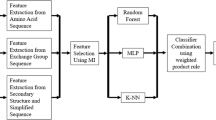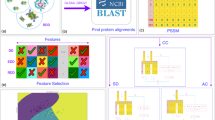Abstract
Classifying the structure of protein is a very important task in biological data. By means of the classification, the relationships and characteristics among known proteins can be exploited to predict the structure of new proteins. The study of the protein structures is based on the sequences and their similarity. It is a difficult task. Recently, due to the ability of machine learning techniques, many researchers have applied them to probe into this protein classification problem. We also apply here machine learning methods for multi-class protein fold recognition problem by proposing a novel hierarchical learning architecture. This novel hierarchical learning architecture can be formed by NN (neural networks) or SVM (support vector machine) as basic building blocks. Our results show that both of them can perform well. We use this new architecture to attack the multi-class protein fold recognition problem as proposed by Dubchak and Ding in 2001. With the same set of features our method can not only obtain better prediction accuracy and lower computation time, but also can avoid the use of the stochastic voting process in the original approach.
Access this chapter
Tax calculation will be finalised at checkout
Purchases are for personal use only
Preview
Unable to display preview. Download preview PDF.
Similar content being viewed by others
References
A. G. Murzin, S. E. Brenner, T. Hubbard, and C. Chothia, “SCOP: A structural classification of proteins database for the investigation of sequence and structures,” Journal of Molecular Biology, Vol. 247, pp. 536–540, 1995.
P. Baldi and S. Brunak, Bioinformatics: the Machine Learning Approach, MIT Press, 1998.
K. C. Chou and C. T. Zhang, “Prediction of protein structural classes,” Critical Reviews in Biochemistry and Molecular Biology, Vol. 30,No. 4, pp. 275–349, 1995.
I. Dubchak, I. Muchnik, S. R. Holbrook, and S. H. Kim, “Prediction of protein folding class using global description of amino acid sequence,” Proc. Natl. Acad. Sci., USA, Vol. 92, pp. 8700–8704, 1995.
I. Dubchak, I. Muchnik, C. Mayor, I. Dralyuk, and S. H. Kim “Recognition of a protein fold in the context of the SCOP classification,” Proteins, Vol. 35, pp. 401–407, 1999.
I. Dubchak and C. H. Q. Ding, “Multi-class protein fold recognition using support vector machines and neural networks,” Bioinformatics, Vol. 17,No. 4, pp. 349–358, 2001.
U. Hobohm and C. Sander, “Enlarged representative set of protein structures,” Protein Science, Vol. 3,No. 3, pp. 522–524, 1994.
T. Jaakkola, M. Diekhans, and D. Haussler, “Using the fisher kernel method to detect remote protein homologies,” Proceedings of the Seventh International Conference on Intelligent Systems for Molecular Biology, pp. 149–158, 1999.
T. Joachims, “Making large-scale SVM learning practical,” in Advances in kernel methods–Support vector learning, B. Scholkopf, C. J. C. Burges, and A. J. Smola (editors), Cambridge, MA, MIT Press, 1998.
C. J. Lin and C. W. Hsu, “A comparison of methods for multi-class support vector machines,” IEEE Transactions on Neural Networks, Vol. 13, pp. 415–425, 2002.
L. Lo Conte, B. Ailey, T. J. Hubbard, S. E. Brenner, A. G. Murzin, and C. Chothia, “SCOP: a structural classification of proteins database,” Nuclear Acid Research, Vol. 28,No. 1, pp. 257–259, 2000.
J. Moody and C. J. Darken, “Fast learning in networks of locally tuned processing units,” Neural Computation, Vol. 1, No. 21,No. 2, pp. 281–294, 1989.
V. N. Vapnik, The nature of statistical learning theory, Springer, N.Y., 1995.
C. H. Wu, Neural networks and genome informatics, Elsevier, U.K., 2000.
Author information
Authors and Affiliations
Editor information
Editors and Affiliations
Rights and permissions
Copyright information
© 2003 Springer-Verlag Berlin Heidelberg
About this paper
Cite this paper
Chung, IF., Huang, CD., Shen, YH., Lin, CT. (2003). Recognition of Structure Classification of Protein Folding by NN and SVM Hierarchical Learning Architecture. In: Kaynak, O., Alpaydin, E., Oja, E., Xu, L. (eds) Artificial Neural Networks and Neural Information Processing — ICANN/ICONIP 2003. ICANN ICONIP 2003 2003. Lecture Notes in Computer Science, vol 2714. Springer, Berlin, Heidelberg. https://doi.org/10.1007/3-540-44989-2_138
Download citation
DOI: https://doi.org/10.1007/3-540-44989-2_138
Published:
Publisher Name: Springer, Berlin, Heidelberg
Print ISBN: 978-3-540-40408-8
Online ISBN: 978-3-540-44989-8
eBook Packages: Springer Book Archive




